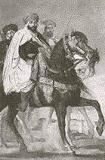History of Cordoba Spain
Cordoba Info
Cordoba Hotels
Restaurants
Food
Photos
Map
History
Monuments
Museums
Festivals
Events
News
Weather
Practical Info
Tips for visitors
Spanish courses
Province
About us
Email
Cordoba was greatly shaped by its long Roman presence (Corduba Colonia Patricia was capital of the province Hispania Ulterior Baetica) and later Moslem occupation (Qurtuba became capital of the powerful Ummayad Caliphate). Both left their monuments and personality. The following is a timeline of Cordoba from its pre-history until the years leading up to the final conquest of Moorish Spain by Isabel and Ferdinand in 1492.
Cordoba Pre-History |
|
|
300,000-35,000 BC (Lower Paleolithic Era) Rudimentary stone tools made from river stones along Guadajoz, El Genil and Guadalquivir rivers. 100,000 BC Neanderthals in Palma del Rio. "Homo fossilis Cordubensis" Neanderthal skeleton found--its late dating may indicate co-habitation with homo sapiens sapiens. Upper Paleolithic: no known archeological findings in near city-remains found in southern province Subética Mountains 4000 BC Neolithic Cave Culture 3000 BC Influx of
peoples from eastern regions (Almeria) |
|
The Iberians in Cordoba |
|
| 7th Century BC - Influx of Indoeuropeans: Punic, Carthaginian and Greek influences arrive from Gades (Cádiz) - Iberian towns: Ategua (ruins north of Espejo), Castro Viejo, Izcar, Iponuba (ruins south of Baena), Torremorana, Ucub (Espejo), Ipagro(?), Monturque - Stellas (Ategua) - Painted, geometrically decorated cups (Archeological Museum) - Iberian sculptures (Archeological Museum) |
 |
|
Romans (760 years
in Cordoba)
|
|
Cordoba During the Republic |
|
Cordoba under the Empire (39 AD-6th Century
AD)
|
|
|
Visigoths (150 years
in Cordoba)
|
|
| 409
Vandals, Suevos and Alanos invade Spain. 458-9 Visigoths expell other Germanic tribes from Spain. Cordoba maintains independence from Visigoth government in Toledo and Byzantine imperial government. 550 In battles between Visigoths and Byzantine Empire, Agila attacks Cordoba and is defeated. 584 Leovigildo takes Cordoba in civil war against his son, Hermenegildo. Cordoba loses autonomous status and lives 150 years of Visigoth rule. |
|
|
Islamic Cordoba (525
years): The Moors in Al-Andalus
|
|
The Emirate of Damascus (711-756) |
|
| 711 - Tariq
leads a group of Moslem soldiers on the conquests of Spain, disembarking
near Gibraltar. His lieutenant, Mugit, conquers Cordoba from Visigoths.
400 Visigoth men besieged outside city in St. Acisclo church for 3
months. 716 - Emir al-Hurr makes Cordoba his administrative center. |
|
|
|
|
Independent Ummayad
Emirate (756-929) |
|
|
Ummayad Califate (929-1031) |
|
|
Taifa Kingdoms (1031-1091) |
|
Almorávide
Period (1091-1147) |
|
Almohade Caliphate
(1147-1236) |
|
|
Christian Cordoba (1236-1475) |
|
| 2nd half XIII
Century - construction of churches and monasteries in city. 1315 Construction of Synagogue. 1328 Alfonso XI completes initial work on reform of Alcazar. 2nd half XIV - Alcazar re-enforced. Inquisition Tower completed. 1369-1386 Wall completed around Alcazar garden. Perhaps Calahorra Tower also built at this time. 1391 Jewry assaulted. At this time the walled southwestern portion of the city, called the Jewry Castle. 1404 Malmuerta Tower built along the northwestern Ajerquía walls. |
Sources: Córdoba Capital, vol. 1, editor Emilio Cabrera, Caja Provincial de Ahorros de Córdoba, 1994 (out of print). Guía Arqueológica de Córdoba, editor Disiderio Vaquerizo Gil, Plurabelle, 2003. Islamic Spain (Architectural Guides for Travellers), Godfrey Goodwin, Penguin Books, 1991 (out of print).
Biographical Index for Cordoba Spain
Articles:
Christopher Columbus and Cordoba
The Historical Context of the Mosque-Cathedral of Cordoba
about us | disclaimer ©2005-2014 Tony Reed

